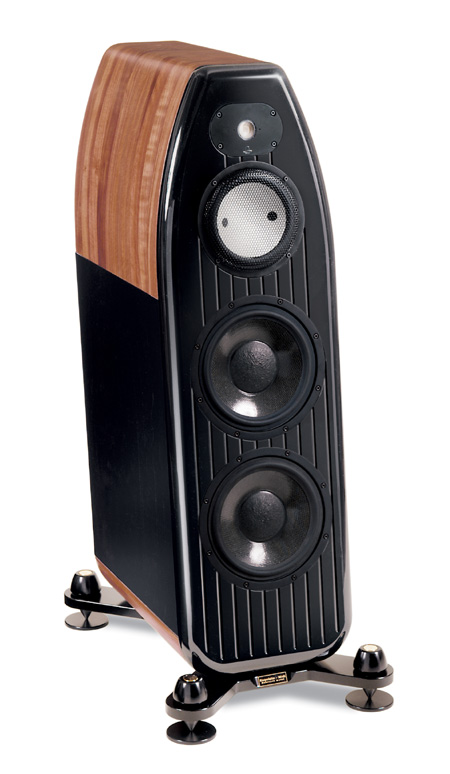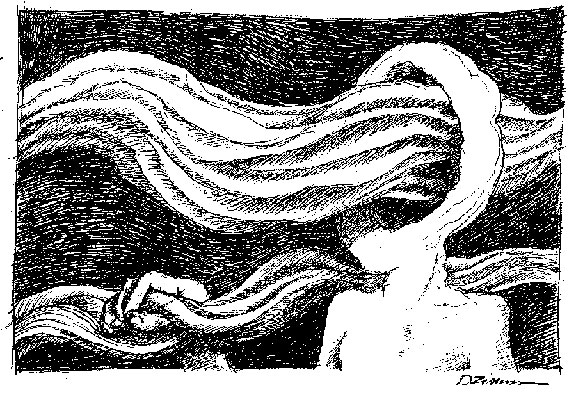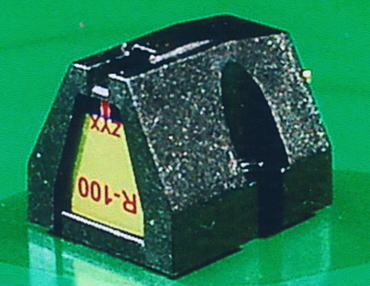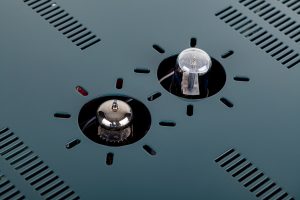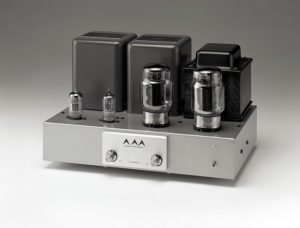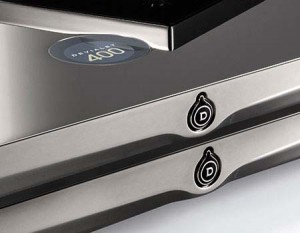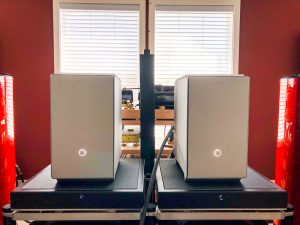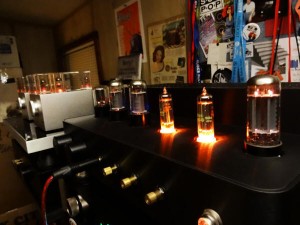This article, as reviewed by Mike Pappas, originally ran when Positive Feedback was in print. Volume 6, Issue 4.
A Pure Class D Project
How did I get into this? Well, our fearless editor David Robinson called me about eight weeks ago and told me one of the most fantastic tales I have ever heard...
It seems he had gotten a call from one of the co-founders of Infinity, a John Ulrick, who was now the owner of a company called Spectron. He had created an amplifier and was looking to get it reviewed. So what is so fantastic about that? Well it seems that this amplifier is a solid state class D pulse width modulated (PWM) amplifier. That's right, a fully digital power amp!
Now many of you know my musical listening propensity leans towards solid state and digital, so David figured I was the perfect person to give this amp a listen.
Now I have to admit that my initial reaction to the whole idea of a digital amp was one of apprehension. I know how difficult it is to build great digital head end gear. I couldn't even imagine what it would take to build a digital power amp that would qualify for audiophile grade. I had a really bad feeling that this was going to be another one of those products that got returned back to the manufacturer as "Not Reviewable".
A couple of days later I got a call from John Ulrick. We spent a couple of hours on the phone discussing him and his amplifier. John has a great story and it's best to let him tell it in his own words.
John Ulrick Tells The Spectron Story
We were supposed to be hard at work designing weapons systems for America—that's me (John Ulrick) and Arnie Nudell. Arnie and I worked at Litton Guidance & Control Systems in Woodland Hills, near L.A. We did build a weapons system, a laser rangefinder that measures the distance from an airplane to the ground for accurate bombing. We were also audiophiles, if there was such a term at the time. The year was 1967. I am an electronic engineer, Arnie a physicist. At Litton, my job was to design the electronics for the laser rangefinder and Arnie's was to design the world's first Q-switched pulsed ruby laser. This was the laser that supplied the pulse of light that went from the airplane to the "target" and bounced back, used to calculate the distance from the airplane to the target. Part of that system involved a mirror to point the laser beam at the target. I designed a servo-control system which points the mirror and its switching amplifier.
During lab testing of the servo-control system, Arnie noticed that the servo was controlling the mirror at 20Hz, a magic number to any audio person. Arnie had a good idea—why don't we make a servo-controlled woofer? We went across the hall to the Litton engineering library and found a book called Acoustical Engineering by Harry F. Olsen—the first bible of acoustics. The book had a page on Servo-Controlled Speakers but no analysis, just a block diagram. We worked together to design the system. Arnie calculated the radiation resistance for the slopes and I designed the servo system and the power amplifier to drive the woofer. Arnie called his friend, Gene Czerwinski, to make a special 18 inch woofer with a second winding to generate the feedback signal. At the time Gene was an engineer at Bendix and making speakers in his garage. Gene later left Bendix to found Cerwin Vega. At this point one could wonder, who is making all these weapons systems?
The woofer worked. There were two more aerospace engineers working at nearby Atomics International, Ron and Bob, making electrostatic panels. (The Pentagon always said you must value the technology spin off from military research!) What a great combination, electrostatic panels that don't have much bass, coupled with an 18 inch servo-controlled woofer. The system was built and set up in Arnie's living room. Using a Sherwood amplifier to drive the electrostatic panels, the tweaking began. The amount of servo feedback changed. The crossover points moved and moved again.
Arnie and I decided to start a company. You could tell by the name there was no professional help in naming the company. The name was "Nutek" for Nudell Ulrick technology. We began selling a system called the "Servo-Static I" through a local dealer. The local dealer was about a mile from Litton and owned by Dr. Jim Henderson, a physicist who you will hear more about later. All of this was still part time with a new guy involved, Cary Christie, a very talented industrial designer making the cabinetry in his garage. Arnie and I put out feelers to raise money and were finally backed by a rep firm that sold me electronic parts at Litton. No sophistication here either; we didn't even have a business plan because we didn't know what one was. A corporation was formed with Arnie and I holding equal interest. Fortunately, when we went to incorporate, the name Nutek was taken. The name Infinity was the third choice on the list, but available. The company name was Infinity, the year 1968.
Again Arnie and I demonstrated our management prowess in choosing who was going to be the first president; we used the coin toss method. I was the president the first year and then we alternated for the first several years. What confusion! In August 1968 myself, Arnie and Cary and a couple of other people started full time in a 2000 sq. ft. building in Chatsworth. Infinity was started. At the start, Infinity had three speakers; the Servo-Static I ($1800), the 2000, a bookshelf with electrostatic tweeters ($276) and the 1000, a 2 way bookshelf speaker.
As time allowed, I started working on a digital switching amplifier based on my switching amplifier experience at Litton. Later my friend Dr. Jim Henderson, now a physicist at Hughes, joined in on the work. With Jim analyzing and me circuit designing, work progressed. Designing the power switching section with the parts available in the mid '70s was a real trick. I used power transistors from TRW which were very expensive. On a good day I could go through $200 worth of them. About a year before the winter CES show in Chicago we naively committed to showing a digital switching amplifier. As the show grew closer, the Infinity gang heard Bose was going to show a switching amplifier. Not wanting to end up second, we pressed on to get a working amplifier ready for the show. For the last three months of October, November and December several people worked straight through, no days off. We spent Christmas morning with our families and met at Infinity in the early afternoon on Christmas day and had the Rose Bowl game on in the lab on New Year's day.
The first day of the show was about Jan 7th. I had airline tickets to fly to Chicago a couple of days before the show opened, but the amplifier wasn't working. Finally, the night before the show, the amplifier was working, but the displays were making a ticking sound. Finally we just disconnected them, listened to the amp for about 15 minutes in the sound room and I caught the last flight that would make the show. I was picked up at the airport at 7 a.m. and rushed to the show. With my coat draped over it, I carried the amplifier past the line of press people waiting outside our room to see an amplifier they thought was in that room. We set it up and it worked! The doors opened at 9 a.m. and we showed the first digital switching amplifier ever. It was 125 watts per channel and ran flawlessly for the four days of the show. Bose didn't show up with a switching amp—thanks!
Following the show, the amplifier was made production-ready and sold as the SWAMP I, a 250 watt per channel amplifier. The name SWAMP came from one of Jim Henderson's computer programs with the file name SWAMP. Infinity sold a few hundred of them. Arnie and I sold our interest in Infinity and I left in 1979. Arnie stayed on as President till about 1990, when he left to start Genesis. Well, Infinity's part of Harman now; they sell through those big chain stores, and the new gang even wears ties to work.
More fun. I had the opportunity to head up a new hi tech company, set up to develop a video multiplexer that allowed the transmission of two TV programs over a single satellite channel with a bunch of guys I loved working with, including Jack with 125+ patents, and Dr. Jim. Big mistake! By the time we completed the research, got all kinds of patents and licensed the thing to a big broadcast equipment company, MPEG had become the standard.
After some time running a computer company and an avionics company to make sure that wasn't what I wanted to do, I started Spectron and began work on a new generation of digital/switching amplifiers. I have always believed in them. It took three years of very long hours. My 600 hp fuel injected drag boat's deck has been used as a table and my Lotus formula Atlantic race car is just waiting to go racing. On the design side, one thing that sure has been a big help this time is all the computer aided math, PCB layout, drafting and simulation; MathCAD, AutoCAD, all that stuff.
It seems to have worked out. Enough people really like the sound, and unlike the Infinity amp, they are very reliable. (The addition of four diodes fixes the Infinity amp—wish I knew that then.) And they are small and light. Even back at Infinity I envisioned a one kilowatt amplifier.
Conceptually, digital amplifiers are simple. You just keep sending pulses of energy alternately from the plus rail and then the minus rail into the speaker and have a feedback circuit to control all these bundles of energy coming from the plus and minus rails. Controlling the voltage at the speaker is like guiding a hockey puck on the ice. First you push from the left and then from the right and you are always making corrections as you guide the puck along the ice. The digital amp gets interesting because you do this 500,000 times a second, so the digital circuits to control corrections must be very fast.
Conceptually, the digital amps are the way to go. They use virtually no analog circuitry (except the input buffer). This eliminates nearly all the analog gain stages, which are inherently slow, each adding a small amount of distortion and delay. It's the slowness of analog circuitry that diminishes the benefits of loop feedback, resulting in an undesirable effect on the sound. In Spectron's digital amp, the audio is converted into a digital signal at the input. From that point on it's processed in high speed digital logic (TTL). The output section involves two FET switches, an inductor and a couple of capacitors which are not in the signal path. If the switches were perfect, with zero turn ON and OFF times, no ON resistance and the logic had no delays, the amp would be perfect. Of course, none of the parts are perfect, but they are getting closer every year.
If all goes well, next time you hear from me, about all I'll have to say is the amps are working great, they just keep going out the door and ya, I've got time to do lunch.
The Spectron Arrives!
A couple of days later UPS rings the door and the Spectron PWM amplifier arrived. I cracked open the box and unpacked it.
The Spectron 1KW's aerospace/milspec legacy is readily apparent in the looks of this amplifier. The no nonsense exterior is formed of a heavy gauge aluminum skin which has a black anodized finish. Phillips head screws are liberally slathered all over the top and sides, as all of the major subassemblies are bolted to both the top and bottom half of the exterior shell. This creates an incredibly strong and lightweight assembly that could probably survive being hit by an anti-tank weapon.
The thick front panel is nicely machined out of aluminum and powder coated with large gold plated volume controls. A cutout located in the center of the front panel has the filter for the fan. A well proportioned power switch is located in the right corner with a corresponding green LED that indicates if the amplifier is powered up. Indicators are provided to indicate if the fan is on and via LED intensity, how much air is being drawn into the amplifier. Two "bar graph" type LED displays are provided for each channel indicating the amount of voltage in ten 8 volt steps and current in ten 5 amp steps being delivered by each channel. The bar graph displays can be a bit disconcerting. I found however, that after a couple of hours I didn't even notice them unless I wanted to know how much power I was putting into the Radians. These displays along with individual channel status and fault indicators are located behind a pair of discreet smoked Plexiglas windows.
On the back of the amplifier, provisions have been made for both balanced inputs on XLR type connectors and unbalanced inputs on RCA jacks. A label on the back notes that the unbalanced inputs are polarity inverting while the balanced inputs adhere to the industry standard pin 2 hot configuration. A pair of 5 way binding posts provide the output connections to the speakers and an IEC type power connector is provided for the mains cable.
Pulling the top cover revealed neat wiring, a good sized toroidal transformer and a pair of power supply caps. A 40 watt switching supply provides power for the displays and the cooling fan. All circuit boards are glass epoxy with the extensive use of surface mount devices to increase density.
The Class D output stages are comprised of 4 MOSFETs per channel which, with their corresponding modulator circuits, are mounted on nicely machined thick aluminum blocks.
I initially couldn't get over how small and lightweight this amp was. I am used to these hulking behemoth power amps that take two guys and a small child to move. In comparison, the Spectron 1KW is tiny, It weighs in at 34 pounds (less than my VIMAK CD transport) and it's only 3.5 inches tall.
Sitting next to my Crown Macro Reference amp, which is a whopping 7 inches tall and weighs in at 65 pounds, the Spectron 1KW looked like the stereotypical skinny kid at the beach. This lack of physical magnitude can be directly attributed to its Class D heritage.
In a conventional solid state amplifier the Class A & AB output stage has about 60% efficiency. Driven at 500 watts into a 4 ohm load, each of the output stages would draw 900 watts (1,800 watts total) from the power supply. Obviously you need a pretty beefy power supply with a large transformer and big caps to keep up with this. Since each of the amp stages are dissipating 400 watts as heat, large heat sinks are needed (or in the case of the Crown, a computer controller fan is used) to keep from melting the output devices.
By comparison, the Spectron 1KW's Class D PWM amplifier stages are 90% efficient. If we drive the 1KW at full rated power of 500 watts into a 4 ohm load, the amp channel is only drawing 550 watts from the power supply. Driving both channels at 500 watts results in drawing only 1,100 from the power supply, which is 700 watts less than a comparable solid state amp. This means that the power supply transformer and caps can be much, much smaller while delivering the same amount of power to the speakers. Due to the high efficiency, only 50 watts per channel is being dissipated as heat. In the case of the 1KW, the heat sinks are very small, with a very tiny fan. If you factor in the efficiency of the power supply, the Spectron 1KW has an efficiency of about 82%. All of this efficiency results in an amplifier that is very compact and lightweight.
Listening To The Beastie
So now with the technical end of the amplifier covered we get down to the really important stuff—how it sounds.
I powered up the Spectron amp and let it run at low level for a couple of days before starting my initial listening tests. I rounded up twice the usual number of my favorite CDs and sat back for a listen.
I started with Pat Metheny's Letter From Home and dialed up the first cut. The next thing that I knew, the CD was over and I was picking up my jaw from off the floor. There's no way that this amplifier is that good!! This disk never sounded like this. The air. The space. The depth. The ease. It just immersed me. This can't be right. It must be some sort of a bizarre symbiotic thing going on with this particular disk.
I grabbed my old reliable Chet Baker and Gerry Mulligan 1974 Carnegie Hall recording and dialed up "Song for Strayhorn." This is really bizarre, I am hearing a triangle that I have never heard before. This gets even weirder as the applause is just like sitting in the hall. I can hear the first person clapping—and the next 10 people joining in—and then the whole hall—and then the applause gradually starts to trail off until I can hear the last person stop clapping. No this isn't possible! There is something uncanny going on here. Is this the Twilight Zone? How could this amplifier be letting me hear all of this?
I have got to try another disk. I grabbed Crosby, Stills, Nash and Young, Four Way Street. This is a funky live recording that has great tunes with what I have always considered to be very marginal engineering. I dialed up "Lee Shore" and sat back for a taste. There is really something off here. The vocal haze that was always on this cut is gone. I can hear the harmonies with crystal clarity that has never existed on any system I have ever heard. I dialed up "Triad" and again the total lack of haze was shocking! The sound stage which used to be constricted was huge and extended way beyond the speakers.
I figure that I am part of some sort of alien audiophile abduction. Kind of like the alien equivalent of "I heard these things that I have never heard before" and "I was transported to a new musical experience level that I never thought was possible." I was waiting for Agent Scully from the Fox series The X Files to break down the door and rescue me!
Well, by now I was in it this thing far enough; I figured that I better get a second opinion to make sure that I haven't been part of some extraterrestrial experiment. I invited an audiophile buddy of mine, John Mikity over for a couple of listening sessions.
I played many of the same cuts as above, and his response was the same as mine: incredulous! This amplifier can't be doing the things that we are hearing. The Spectron 1KW was presenting us with an incomprehensible amount of stunningly musical information that we had never heard before.
So now we have a challenge. Let's dig up some old moldy stuff and let's see what this amp can do to it. We try firing up Neil Young's Harvest CD, and we dial up "Old Man". The first thing that we noticed was that the kick drum, which always sounded like a flatulating lawn mower had been fixed. The kick drum now had click, snap, and punch. There is a piano part that floats in which, until we listened to this amplifier, we had never heard.
Since words are the tools of the audiophile writer, we will try to reiterate what we think we are hearing in the typical audiophile jargon.
Sound stage: John says you can swim through the layers and textures. I say that it is gloriously wide and deep with everything in it's proper perspective. We both agree that we haven't had an amp in this system that got even close to presenting the delicate tapestry of a sound stage like the Spectron did.
Imaging: Like a rock with pinpoint accuracy that doesn't change with amplitude. Images just locked right in and soon after you start listening, you forget that imaging was ever anything that used to be a problem. After five 3 hour listening sessions, we both concurred that we had never heard any amplifier that could convey this kind of "dead on" imaging accuracy.
Air: Oh Baby, does this amp have air. The overhead cymbals on the Pat Metheny recordings will launch you into another universe. The air that surrounds cymbals, percussion and the like are one of the true wonders of this amplifier.
Dynamics: Certified to be Space Shuttle launch capable. For example, we were playing a Dire Straits cut from their On Every Street recording. I had cranked up the level and my cat, Talos, was laying down on the floor between the speakers. We rolled into the cut and when the snare drum got whacked, Talos shot straight up in the air about three feet and vanished! This amp has got better transients and macro dynamic resolving power than anything I have ever been exposed to.
Power: By now you all know that I am a major power junky. The way I figure it is if your amp wimps out when you push it, the transients just won't get through (except as nasty clipping artifacts). Rest assured dear reader, that this amplifier has the necessary power to get just about any transient, short of thermonuclear warfare, through even the most inefficient speakers made. Since I am a charter member of the "More Power, Dammit Scotty!" hall of fame, I am hoping that Spectron will offer a bridged mono pair for those of us looking for the ultimate in headroom. (Ask and ye shall receive; check my note at the end of this review!)
Control: This amp has more authority than a room full of control freaks. Tight snap and great damping factor make this amp have some of the best woofer control that I have ever heard!
Haze: This amp has more clarity than the repaired Hubbell space telescope. It will open up your music like a crystal clear picture of a far off galaxy. Absolutely nothing gets lost in the transition from soft to loud and back to soft. This is a problem that every linear amplifier that I have ever heard could not totally resolve. Words are incapable of fully describing the sheer resolving power of this amp.
Musicality: Oh my god, this amp has all of the above and to top it off, it's musical! For a full dissertation on the amplifier's musicality, see the next section below.
Turn it on and Crank it up factor: You have all heard (or maybe owned) gear that did everything "right"—and you just didn't want to spend any time listening to it. Well the Spectron 1KW isn't one of them. This is a 100% guaranteed toe tapping, drink a whole bottle of single malt until the sun comes up, want to play more until the wife tosses everybody out kind of a product. Suffice it to say that metaphorically speaking, this amplifier goes to 11 on a scale of 1-10...
An example of what I mean is in order at this point. First you need to get in to Mr. Peabody's "Way Back" machine and set the time indicator to 1972. When the door opens, get out and remember when you first heard Emerson, Lake and Palmer's Trilogy. Nice tunes but not a world class recording. Wrong! With the exception of the piano on the Sheriff cut (which gets a bit crunchy on the crescendo), this recording has got great sound. The drum introduction on the "Sheriff" cut has impressive snap, killer transients, and the vocals will knock you and your preconceived notions right on your butt.
On recordings made during the pre-digital time millennium, the analog tape hiss is certainly present, but with this amplifier it is not objectionable like it was with other amplifiers. You can hear it, but it doesn't have the edge that used to drive me right up a wall.
OK, so maybe both John and myself were abducted by audiophile aliens, but I don't think so. I think we were both shanghaied by one of the finest audio amplifiers that we have ever heard, and through it, transported to a new universe of listening pleasure.
"So how do you really feel about this amplifier?"
The Spectron 1KW amplifier redefines the state of the art in power amplifier designs. It does everything right, so right that words cannot totally convey what this amplifier is capable of doing. (Yeah, I'm considering setting fire to the old word processor!) And that isn't the half of it. I've saved the best for last. If this amp cost an arm and a leg, or you had to auction your significant other to even daydream about it, that would be one thing. You could read this review, shrug your shoulders, and say, "Hell! Another damned amp I can't possibly afford!"
BUT—and hang on to yer shorts, Mort—at an MSRP of just $3495, the Spectron 1KW is a bona fide killer! Competitors are hereby served notice that the Spectron 1KW is a bone-bustin' foe requiring a wide berth....
Even more: wait until I tell you about what a mono pair of these suckers did to my sweet spot!





